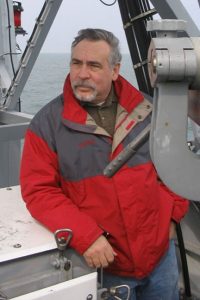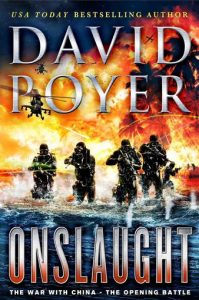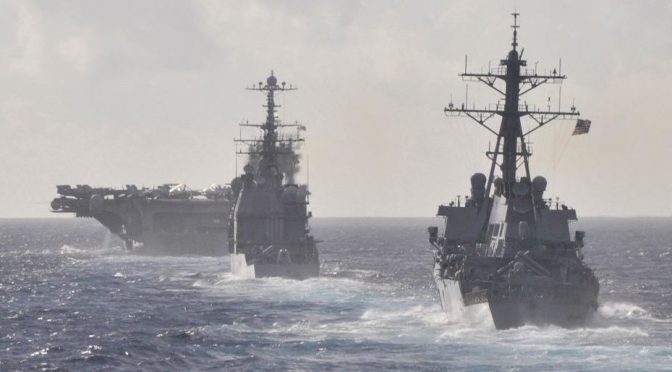By CIMSEC Book Review Team
CIMSEC sat down with author David Poyer, former naval officer and author of the ‘Tales of the Modern Navy’ series of novels, among other exciting modern and historical naval fiction titles. Poyer’s latest title, Onslaught, finds protagonist Dan Lenson in command of USS Savo Island during the opening salvo of the war with China. Poyer’s masterful character development, eye for technical details, and comprehensive understanding of life at sea have made him a favorite of fans of this genre. We asked him about his writing process, inspiration, and more.
CIMSEC: You do an excellent job of combining intrigue and drama with technical details and action. How do you do this and how do you begin the writing process?
DP: Thanks! I’m notoriously process-oriented, having been originally educated as a naval officer and engineer, and worked as a submarine systems designer before going into fiction. These days, though, I teach narrative structure at the Creative Writing Program at Wilkes University. So…here goes!
A quick overview: I begin with a general plot idea, then sketch out how each character will contribute to the overall story. Next, I construct the arcs for those characters. During this process, scenes will have started to come to me. Also, thoughts for more scenes and plot points occur as I do background reading and interviews and ship visits.
Eventually I generate a ten-to fifteen-page single-spaced outline of the action proper of the novel. This “blueprint,” plus the character studies, makes it possible for me to cruise through the first draft at a rate of about four pages a day without too much angst, and without excuses or writer’s block.

Of course, six months later, that only gives me the first draft! Lenore Hart, my better half who’s also a novelist, reads the second draft and makes extensive comments I revise. Then a varied stable of retired and active duty Navy, Marine, NCIS, State, physicians, and many other subject matter experts comment on their sections. After that I revise again. (I put a lot of time and effort into trying to make events and descriptions as authentic as possible, while still driving the action forward with drama and suspense). Four to five drafts later, after I’ve cut out every possible excess word, it’s time for my editor at St. Martin’s, George Witte, to see it!
CIMSEC: What do you think readers, especially readers in the naval profession like many of our readers here at CIMSEC, can derive from your narrative? What are you trying to convey?
DP: I started out as a writer simply wanting to recount and reflect on my own early experiences at sea. The Med, The Circle, and The Passage were based on specific cruises, events, and locales I saw during active duty. For example, The Circle was inspired when USS Bowen deployed north of the Arctic Circle in winter, with orders to find the biggest storm around and stay in it as long as we could. (This was to test a new sonar system). So I didn’t have to research what Arctic storms looked and felt like!
In terms of artistic intent, at first I was largely innocent. Mainly I wanted to craft an exciting story. If a deeper theme emerged, great. And over the years I’ve been blessed with some critical acclaim. But the reviews that warm my heart most are from the enlisted, chiefs, and officers who write to thank me for a realistic portrayal of the sacrifices they’ve made. If I can bring such stories to a general audience as well, I’ve met my basic requirements.
A few recurrent motifs or themes do underlay my work, but they’re not buried so deeply you need a PhD in literature or philosophy to winkle them out. After my first dozen or so novels, I realized that every work had been about the question, ‘What is the ultimate authority or guide we can depend on for ethical action?’ I don’t really concern myself much with “identity,” which much current fiction seems occupied with. I know who I am, and my characters, in general, know who they are. That doesn’t mean they aren’t conflicted and uncertain. I’m attracted to deeply-layered, multidimensional characters who act as well as think. But to act means to decide; to choose. As John Gardner, one of my early mentors and exemplars put it, every novel is, at its deepest heart, a morality play.
That, I think, is why some of my novels have been taught at the Naval Academy: they’re not simply thrillers; they’re about difficult choices made in short time frames under terrible stress. Exactly what sometimes happens at sea.
CIMSEC: Onslaught explores a hypothetical conflict with China. How much of what you include in your novels is inspired by current events and what other sources do you call on for inspiration?
DP: I started research and planning of the War with China series – The Cruiser, Tipping Point, Onslaught, and two more books now in progress – well before tensions with that country reached the  current near-boiling point. You have to realize, a novel is written at least two years before you see it on the shelves; a year to write, and a year in production. Complex and research-intensive ones take even longer. So I can’t really tune too close an ear to current events. Nor am I psychic! The books are thus based on my own strategic calculations and a knowledge of history. (I did the same thing earlier with The Gulf). Around 2008 I asked myself, What if there were a new Pacific war? Everything downstream flowed from that initial “what if.”
current near-boiling point. You have to realize, a novel is written at least two years before you see it on the shelves; a year to write, and a year in production. Complex and research-intensive ones take even longer. So I can’t really tune too close an ear to current events. Nor am I psychic! The books are thus based on my own strategic calculations and a knowledge of history. (I did the same thing earlier with The Gulf). Around 2008 I asked myself, What if there were a new Pacific war? Everything downstream flowed from that initial “what if.”
CIMSEC: It seems as though your last two works bore some resemblance to the outbreak of the First World War and the geopolitical tensions that characterized that time in history. Was this intentional?
Very much so; in fact I refer in the narrative to Dan Lenson’s reading of Barbara Tuchman’s The Guns of August. The problem the U.S. faces in accommodating a previously stable international structure to the rise of a peer competitor is much like that which the British Empire faced in dealing with Imperial Germany, or Rome with Carthage, or even farther back, Sparta vs. Athens. Other influences are Sallust, Gibbon, Thucydides, the battles of Savo Island and Guadalcanal, Korean medieval history, the tactics of Ulysses S. Grant, and Allied op plans (both executed and not) for the latter stages of WWII, among many others.
I loved the comparison between the skills of ancient mariners and modern high-end war; specifically I am thinking of the instance in which your Chief Quartermaster takes a celestial fix – I pictured him doing so on the port bridge wing above the SPY faces. That really conjured an image for me of the juxtaposition of ancient naval practices and modern technology.
I think one of the distinguishing themes of sea fiction, what Professor Herb Gilliland of the Naval Academy calls “techné,” the machinery that’s mastered (or at least used) in sea tales.
The most complicated device existing in the 18th century was a full-rigged warship, and its present-day successors are among the most complex devices today. Think of The Sand Pebbles; if you took the machinery out there wouldn’t be much book left. Or Delilah by Marcus Goodrich, the crew manhandling and shoveling all that coal from the bulkhead bunkers into the boilers. Under technique also falls seamanship, and the skills and even artistry involved in steering safely through changing weather and sea conditions.
And you’re right, at sea today we have to be masters of both an ancient set of skills and comfortable at the very cutting edge of 21st-century technology. Both the fascination and the challenge for me lies in making the advanced technology involved in, say, intercepting an incoming ballistic missile terminal body with an Aegis-steered Standard missile comprehensible to the general or lay audience. Sometimes I fail in that regard; I remember one reviewer wrote, “I learned more about the Navy than I really wanted to know.” Not the impression I wanted to leave!
In general, if I hear equal numbers of readers complaining that I didn’t go deeply enough into the techné, and others that I got too technical and acronymophilic, I should be roughly in the middle of the channel. Complicating that further in the later books in this series will be that war inevitably accelerates technology…which means I may have to go beyond anything currently used in the Fleet.
CIMSEC: Crime aboard ships is a common thread throughout the series – why is that? Is this intentional and is this something you have personal experience with, or is it just a storytelling device?
Well, crime isn’t as prevalent in the USN as it is in my series, that’s for sure. On the other hand, we’ve all read about service-related cases of bribery, sexual abuse, rape, theft, counterfeit parts, murder. Every crime ashore has its cousin at sea. It would actually be unrealistic to pretend it doesn’t happen.
War and crime seem analogous in certain ways. They force choices and actions, and sometimes very difficult ones, on both the participants and those who must find the perpetrator and administer justice. Remember your high school lit classes, where they talked about the various forms of antagonists: human, animal, natural, corporate, governmental, enemy, etc? The more of these conflicts I can layer into the story, the more complex and punishing it becomes for the characters, the greater the forward velocity and the more strongly the reader becomes involved.
CIMSEC: Your story features very competent but very diverse female characters, which is a rarity in this genre of fiction. Is this an important message to you as an author and former naval officer or a reflection of the makeup of a modern crew at sea?
I don’t think it’s as much some kind of “message” as a reflection or realization that this is how things are now, both at sea and ashore. Still, it took me a few novels to feel comfortable with portraying a female voice or point of view. My first two or three novels weren’t that effective  in portraying black, female, or gay characters. But as I moved out of the all-white environment I grew up in, and as the rather homogeneous and all-male Navy of the 1970s and 80s changed, my views widened. My first book with a female central intelligence was The Whiteness of the Whale, with Dr. Sara Pollard. I’m happy with the way that turned out and it got some very pleasant reviews.
in portraying black, female, or gay characters. But as I moved out of the all-white environment I grew up in, and as the rather homogeneous and all-male Navy of the 1970s and 80s changed, my views widened. My first book with a female central intelligence was The Whiteness of the Whale, with Dr. Sara Pollard. I’m happy with the way that turned out and it got some very pleasant reviews.
To take it a step farther, I don’t believe a writer should or can be limited to drawing characters that reflect only his or her own ethnicity and gender. Providing access to the interior thoughts and feelings of what the reader considers the “other” is one of the primary functions of fiction. But with that freedom also comes a responsibility: to portray every character as truly and complex as possible, without defaulting to clichés or cardboard villains. One of the most difficult characters I ever had to inhabit was the treacherous, fanatical Al-Maahdi in The Crisis. But eventually I understood why he became what he became. That’s not the same as sympathizing with his actions, of course.
CIMSEC: Your characters are drawn in a way that is so sophisticated and complex – are they based in any way on individuals you’ve served with?
DP: Sometimes!!
CIMSEC: Onslaught features a total breakdown of the international system and diplomacy, as we know it. Is this something you feel we are moving toward?
DP: Unfortunately, nations do seem to be demolishing or abandoning, one by one, the international structures and norms that promoted accommodation, protected human rights, and acted to prevent war. China dismisses the rulings of international courts. The U.S. behaves more and more cavalierly toward long-time allies. The president of the Philippines brags about his extrajudicial killings. Russia subverts any democracy it can. Combine these with a decline in the former relative preponderance of U.S. power in the western Pacific, and the events in Tipping Point and Onslaught begin to seem not just possible, but all too likely.
CIMSEC: What message do you hope junior officers and sailors reading your novels can take away and apply to their profession?
Nothing unique or new, I fear. Merely this:
Know your job.
Care for your troops.
And always try to do the right thing, even if it may hurt your career.
CIMSEC: Where does the series go from here and what’s next for Daniel Lenson?
DP: After the opening of the Pacific war in Tipping Point, and its first battles in Onslaught, the next strategic question will be: can the Allies hold the central Pacific? IF we can’t, then no recovery and new offensive farther west is possible. Of course Dan, Blair, Obie, and Cheryl will all be in the thick of the action. So look for Hunter Killer in December of 2017…and thanks for the interview!
David Poyer was born in DuBois, Pennsylvania in 1949. He grew up in Brockway, Emlenton, and Bradford, in western Pennsylvania, and graduated from Bradford Area High School in 1967. He graduated from the U.S. Naval Academy at Annapolis in 1971, and later received a master’s degree from George Washington University.
His active and reserve naval service included sea duty in the Atlantic, Mediterranean, Arctic, Caribbean, and Pacific, and shore duty at the Pentagon, Surface Warfare Development Group, Joint Forces Command, and in Saudi Arabia and Bahrain.
Poyer began writing in 1976, and is the author of over forty books, including THE MED, THE GULF, THE CIRCLE, THE PASSAGE, TOMAHAWK, CHINA SEA, BLACK STORM, THE COMMAND, THE THREAT, KOREA STRAIT, THE WEAPON, THE CRISIS, THE TOWERS, THE CRUISER and TIPPING POINT, best-selling Navy novels; THE DEAD OF WINTER, WINTER IN THE HEART, AS THE WOLF LOVES WINTER, and THUNDER ON THE MOUNTAIN, set in the Pennsylvania hills; and HATTERAS BLUE, BAHAMAS BLUE, LOUISIANA BLUE, and DOWN TO A SUNLESS SEA, underwater adventure. Other noteworthy books are THE ONLY THING TO FEAR, a historical thriller, THE RETURN OF PHILO T. McGIFFIN, a comic novel of Annapolis, and the three volumes of The Civil War at Sea, FIRE ON THE WATERS, A COUNTRY OF OUR OWN, and THAT ANVIL OF OUR SOULS. He’s also done two well-reviewed sailing novels, GHOSTING and THE WHITENESS OF THE WHALE, and several nonfiction books. Two books will appear later this year: ONSLAUGHT, another Modern Navy novel, and ON POLITICS AND WAR, co-authored with Arnold Punaro.
Poyer’s work has been translated into Japanese, Dutch, Italian, and Serbo-Croatian, recorded for audiobooks, published as ebooks, selected by the Literary Guild and Doubleday Book Club, etc. Rights to several properties have been sold or optioned for films.
Poyer has taught or lectured at Annapolis, Flagler College, University of Pittsburgh, Old Dominion University, the Armed Forces Staff College, the University of North Florida, Christopher Newport University, and other institutions. He has been a guest on PBS’s “Writer to Writer” series and on Voice of America, and has appeared at the Southern Festival of Books and many other literary events. He currently a fellow at the Virginia Center of Creative Arts, and teaches in the MA/MFA in Creative Writing program at Wilkes University in Wilkes-Barre and at the Ossawbaw Island Writers’ Retreat. He lives on Virginia’s Eastern Shore with his wife, novelist Lenore Hart.
Featured Image: PACIFIC OCEAN (June 16, 2009) – Nimitz-class aircraft carrier USS George Washington (CVN 73), Ticonderoga-class guided-missile cruiser USS Cowpens (CG 63) and Arleigh Burke-class guided missile destroyer USS Fitzgerald (DDG 62) steam in formation during a photo exercise June 16. (U.S. Navy photo by Mass Communication Specialist 2nd Class Bryan Reckard)

